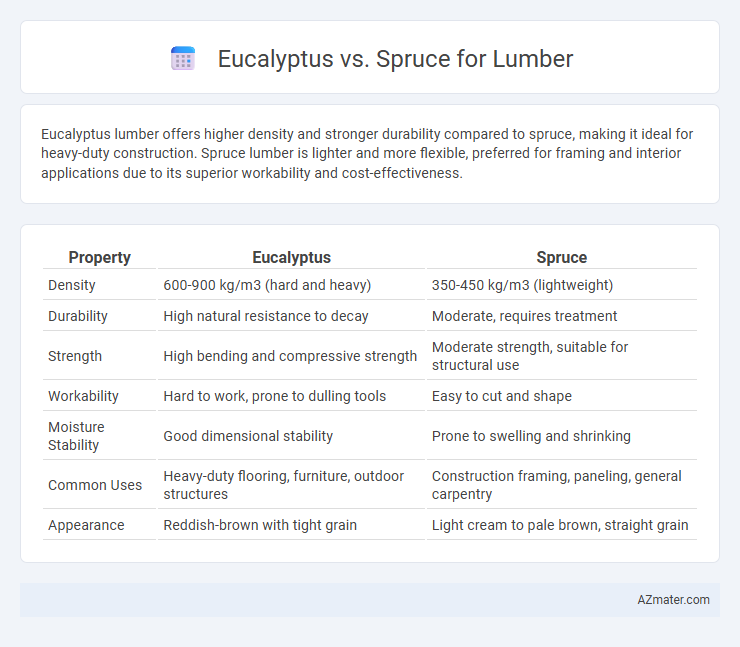Eucalyptus lumber offers higher density and stronger durability compared to spruce, making it ideal for heavy-duty construction. Spruce lumber is lighter and more flexible, preferred for framing and interior applications due to its superior workability and cost-effectiveness.
Table of Comparison
| Property | Eucalyptus | Spruce |
|---|---|---|
| Density | 600-900 kg/m3 (hard and heavy) | 350-450 kg/m3 (lightweight) |
| Durability | High natural resistance to decay | Moderate, requires treatment |
| Strength | High bending and compressive strength | Moderate strength, suitable for structural use |
| Workability | Hard to work, prone to dulling tools | Easy to cut and shape |
| Moisture Stability | Good dimensional stability | Prone to swelling and shrinking |
| Common Uses | Heavy-duty flooring, furniture, outdoor structures | Construction framing, paneling, general carpentry |
| Appearance | Reddish-brown with tight grain | Light cream to pale brown, straight grain |
Introduction to Eucalyptus and Spruce Lumber
Eucalyptus lumber, sourced from fast-growing hardwood trees primarily native to Australia, offers high density, strength, and natural resistance to decay, making it suitable for structural and furniture applications. Spruce lumber, derived from softwood conifers common in North America and Europe, is valued for its lightweight, fine grain, and excellent strength-to-weight ratio, often used in construction, musical instruments, and paper production. Both woods provide distinct advantages: eucalyptus for durability and hardness, spruce for flexibility and ease of working, influencing their selection based on specific project requirements.
Botanical Overview: Eucalyptus vs Spruce
Eucalyptus trees, belonging to the Myrtaceae family, are fast-growing hardwoods primarily native to Australia and are characterized by their dense, durable wood suitable for heavy construction and flooring. Spruce species, part of the Pinaceae family, are softwoods predominantly found in cooler northern hemisphere climates, recognized for their lightweight, straight-grained timber commonly used in structural framing and paper production. The botanical differences between Eucalyptus and Spruce significantly affect their growth rates, wood density, and applications in lumber industries.
Growth Regions and Sustainability
Eucalyptus thrives in tropical and subtropical regions such as Australia, South America, and parts of Africa, offering rapid growth rates that support sustainable timber production. Spruce predominantly grows in cooler temperate zones across North America and Europe, with slower growth that demands careful forest management to maintain sustainability. The sustainability advantage of eucalyptus lies in its fast growth and ability to regenerate quickly, while spruce's established ecological role promotes biodiversity in managed forests.
Wood Appearance and Grain Characteristics
Eucalyptus lumber features a rich, warm color palette ranging from light amber to deep reddish-brown, with a pronounced interlocking grain pattern that adds visual interest and durability. Spruce wood presents a pale, creamy color with a straight, fine grain, offering a more uniform and smooth appearance favored for its consistency in structural applications. The contrasting grain characteristics make eucalyptus ideal for decorative uses, while spruce is preferred where a clean, refined look and ease of finishing are desired.
Strength and Durability Comparison
Eucalyptus lumber exhibits high strength due to its dense grain structure, making it suitable for heavy-duty construction and outdoor applications where durability is essential. In contrast, spruce is lighter and less dense, offering moderate strength with superior flexibility, commonly used in framing and interior projects. Eucalyptus also provides better resistance to decay and insect attacks compared to spruce, enhancing its longevity in challenging environments.
Workability and Machining Properties
Eucalyptus lumber exhibits excellent workability with good machinability, allowing smooth cutting, shaping, and sanding due to its moderate density and uniform grain structure. Spruce is favored for its lightweight and straight grain, enabling easy machining and clean, precise cuts, making it ideal for fine woodworking and structural applications. Both woods offer distinct advantages for different projects, with eucalyptus providing durability and resilience, while spruce delivers superior ease in mechanical processing.
Resistance to Pests and Rot
Eucalyptus lumber exhibits high natural resistance to pests and fungal decay due to its dense grain and natural oils, making it suitable for outdoor and structural applications in damp environments. Spruce, while lightweight and easy to work with, offers lower durability against insects and rot unless treated with preservatives, limiting its use in exposed or high-moisture conditions. Choosing eucalyptus over spruce enhances long-term performance and reduces maintenance costs in pest-prone and humid settings.
Environmental Impact and Carbon Footprint
Eucalyptus lumber demonstrates a lower carbon footprint due to its rapid growth rate and efficient carbon sequestration compared to spruce, which grows slower and stores less carbon over time. The environmental impact of eucalyptus is also influenced by its ability to regenerate quickly, reducing deforestation pressures, whereas spruce harvesting can lead to longer recovery periods and potentially higher ecological disruption. Sustainable eucalyptus plantations contribute to carbon neutrality by balancing timber extraction with reforestation, while spruce forests require careful management to maintain biodiversity and soil health.
Common Uses in Construction and Carpentry
Eucalyptus lumber is commonly used for flooring, decking, and outdoor furniture due to its durability, natural resistance to decay, and attractive grain patterns. Spruce wood is frequently utilized in framing, paneling, and interior trim because of its lightweight strength, ease of machining, and uniform texture. Both woods serve specific roles in construction and carpentry, with eucalyptus excelling in exterior applications and spruce favored for structural and indoor projects.
Cost and Availability Analysis
Eucalyptus lumber generally offers a lower cost compared to spruce due to its fast growth rate and widespread plantation availability, particularly in regions like Australia and Brazil. Spruce, often sourced from colder climates such as Canada and Scandinavia, tends to have higher prices reflecting slower growth and limited harvesting seasons. Availability of eucalyptus is more consistent year-round, while spruce supply can fluctuate seasonally, impacting both pricing and procurement strategies for construction and furniture industries.

Infographic: Eucalyptus vs Spruce for Lumber
 azmater.com
azmater.com